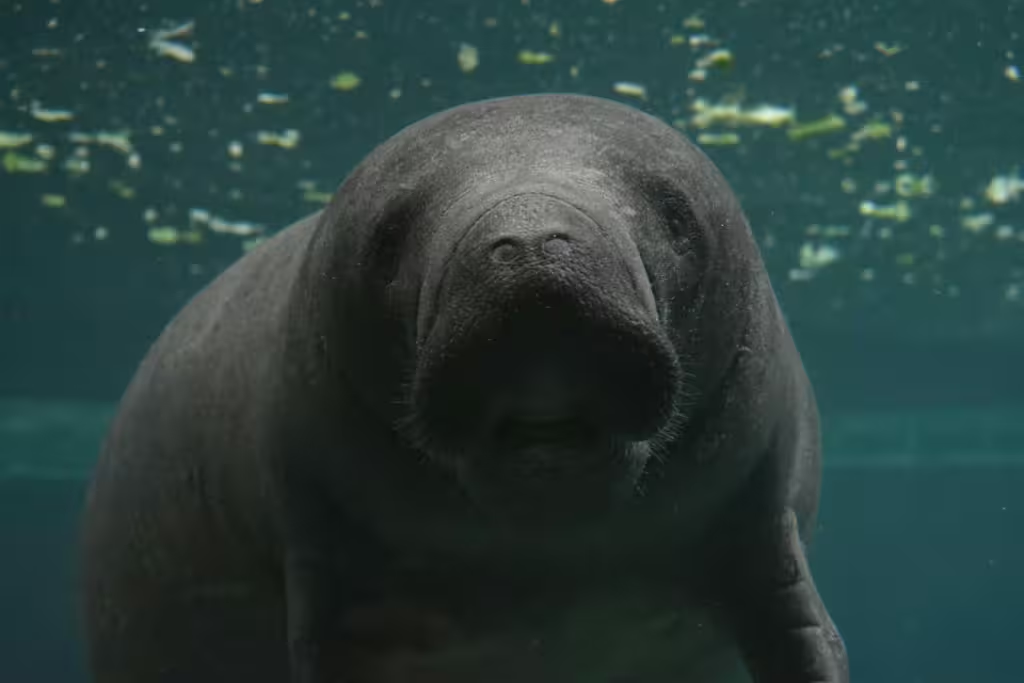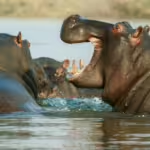We have talked about dolphins and whales on this site; two of the most intelligent, most charismatic classes of marine mammals on the entire planet. Beneath them on the charisma scale, we have seals, then walruses, and if we had to pull a one up from the bottom, we would likely find the likes of manatees and dugongs. The thing is, nature is hardly a popularity contest; nor should it be, and while these squat, wrinkly, chubby aquatic mammals are not the most well-known of their ilk, they are no less remarkable.
Manatees and their relatives are incredible examples of adaptation. They inhabit warm, shallow waters and are most well-known for their docile demeanor and approachable nature. They are curious mammals, often referred to as sea cows. Thanks to their entirely plant-based diet, these creature are quite crucial to the ecosystems they call home.
Sadly, like so many unique marine species, the sea cow faces numerous threats due from human beings. Whether from climate change, habitat destruction, or the mere existence of motor boats in and around their homes, manatees are in grave danger. In many ways, their existence reminds us of the fragility of aquatic ecosystems.
In this article, we will explore the lives of both manatees and dugongs. We will discuss their environmental importance, and the many challenges they face. At the sam time, we will delve down into history to talk about one of their extinct relatives, the Steller’s sea cow, and the familiar-sounding circumstances that ultimately led to its demise.
Manatees and Dugongs: The Basics
Manatees and dugongs might bear certain resemblance to seals, walruses, and other pinnipeds, but they actually belong to the order Sirenia, a group that once included the now-extinct Steller’s sea cow. There are only three known members of this group and though they all share many similarities, there are distinct differences between the two surviving ones.
Manatees
Contrary to popular belief, manatees can be found in both freshwater and saltwater environments. There are three species of manatees:
West Indian Manatee (Trichechus manatus): This is the most familiar species of manatee, mainly due to the conservation concerns surrounding its continued existence in the rapidly-disappearing Florida Everglades. These animals aren’t just found in Floridan swamp waters, however, and have been found in the Caribbean, the Gulf of Mexico, and in both Central and South America.
The West Indian manatee can grow up to 13 feet in length and weigh more than 2,900 pounds. It has the distinctive robust body and paddle-shaped tail of its fellow Sirenians. These gentle giants are listed as “Vulnerable” because they are constantly threatened by habitat destruction, boat collisions, and climate change. Conservation efforts, including protected areas and speed limits for boats, have been largely vital for their continued survival.
Amazonian Manatee (Trichechus inunguis): This specialized animal is native to the freshwater rivers and tributaries of the Amazon Basin. It is the smallest of the three manatee species, measuring up to 9 feet long and weighing only around 990 pounds. Herbivorous, as all sirenians are, this breed has smooth, grayish-brown skin and a paddle-shaped tail, making it well-adapted to its riverine environment. Like the West Indian manatee, this species is listed as “Vulnerable” due to threats like habitat destruction, poaching, and accidental entanglement in fishing gear.
West African Manatee (Trichechus senegalensis): Found along the west coast of Africa, this large herbivorous aquatic mammal lives in rivers, estuaries, and coastal lagoons from Senegal to Angola. It is a more elusive and skittish breed than the other two varieties, but looms large, nevertheless. Growing up to 13 feet long and weighing an impressive 1,100 pounds, the West African variety has a streamlined body with a paddle-like tail. It too has been listed as “Vulnerable” by the IUCN, because even this variety faces threats from habitat loss, hunting, and accidental entanglement in fishing nets.
All breeds of manatees are characterized and most easy recognized by their paddle-shaped tails, rounded bodies, and whiskered, scrunched faces. Most can grow up to 13 feet long and weigh as much as 1,300 pounds; more in some cases.
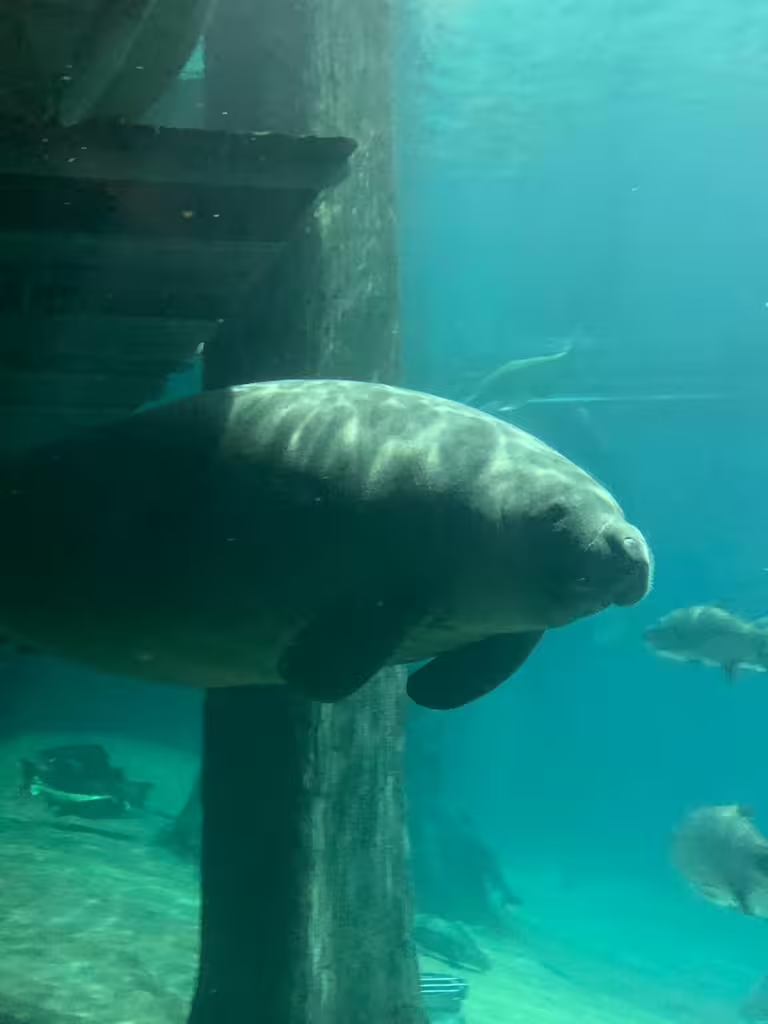
Dugongs
Unlike the three species of manatees discussed above, dugongs (Dugong dugon) are exclusively marine animals. These animals do not live in freshwater rivers and are typically found in the warm coastal waters of the Indian and western Pacific Oceans. Most of them live close to or around Australia. Unlike manatees, which have paddle-like tails they can use to meander through estuaries and riverine waterways, dugongs have fluked tails similar to dolphins. They also tend to be smaller than most manatee species, measuring about 10 feet long and weighing closer to 900 pounds.
Their Role in the Ecosystem
Both manatees and dugongs are exclusive herbivores, feeding on seagrass and other aquatic vegetation. Their feeding and grazing habits actually play a vital role in maintaining healthy aquatic ecosystems:
Seagrass Maintenance: A manatee’s favorite food is seagrass and by merely grazing on seagrass beds, these animals are helping to maintain their habitat. Eating seagrass prevents overgrowth and helps stimulate new growth, which then supports biodiversity within the manatee’s ecosystem.
Nutrient Cycling: As they digest plants, manatees and dugongs release nutrients into the water as their dung. This consistent biological action promotes the growth of microorganisms that form the important base of aquatic food webs. Many people don’t realize this, but bacteria and other microorganisms are a vital piece of what makes all food chains work in homeostasis. When these bacteria populations drop off, every link on the chain is affected; and many can even be broken as a result.
Sediment Management: The same grazing activities that help keep grass low and regrowing also help reduce the accumulation of sediment, which actually keeps waterways clearer and healthier for the other animals that share them with the manatees.
Manatees and Dugongs Around the World
Amazonian Manatees
The Amazonian manatee is also quite unique among its sister species in that it lives exclusively in freshwater. This creature can be found meandering around the Amazon Basin, where it prefers slow-moving rivers, lagoons, and flooded forests to coastal waters. The Amazon manatee’s diet consists only of aquatic vegetation, and they have been known to travel long distances in search of food during the dry season. That is why these manatees also tend to be smaller than their Floridian and African cousins, because like the pink Amazonian river dolphin, these manatees need to be lighter and more flexible in order to move about the flooded forests and sometimes very low water levels of their Amazonian home.
Florida Manatees
The West Indian manatee, particularly the subspecies that hangs around the Florida Everglades, is iconic in the southeastern United States. Though they like living in rivers and coastal waterways most times, these manatees are often spotted in the warm springs or even in and around power plant discharge areas during the winter months. This is due to the fact that these manatees simply cannot survive in water temperatures below 68°F.
Dugongs in Australia
Australia is home to some of the mot unusual creatures on the planet and obviously the extremely unique dugong is amongst that grouping. Australia actually has the largest populations of dugongs in the Indian and Western Pacific ocean. These animals swim in seagrass meadows that abut the Great Barrier Reef and Shark Bay, where they play a crucial role in maintaining the health of these and all adjacent marine ecosystems. Dugongs also happen to be culturally significant to Indigenous Australian communities, who have historically hunted them for food and used their bones and tusks in traditional practices for generations.
Endangered Status and Threats
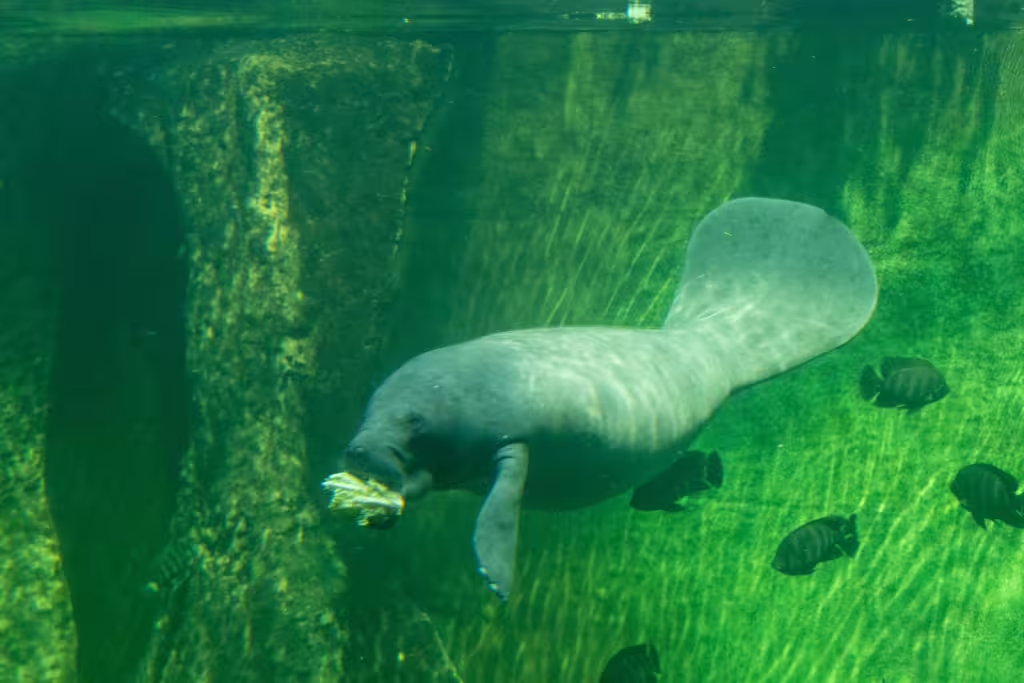
It should come as no surprise that, specialized as these animals are, they face numerous threats in the current ecological climate, ranging from habitat destruction to direct human impacts on their survival.
Habitat Loss
The destruction of seagrass beds and other coastal habitats due to pollution, dredging, and coastal development are a constant threat to manatee and dugong populations all over the planet. Whether it’s coral bleaching in the Great Barrier Reef, rampant deforestation in the Amazon River Basin, or increased global temperatures drying up African riverbeds, these animals are in danger. Additionally, damming and waterway alterations have vastly reduced suitable habitats for manatees that dwell in freshwater ecosystems.
Boating Collisions and Fishing
Floridian manatees have another threat affecting their daily lives, that of human boats and fishing equipment. Thanks to their slow movement and need to surface for air, these gentle giants frequently suffer injuries or fatalities due to collisions with boats. Meanwhile, manatees there and elsewhere often become tangled by the detritus of careless anglers, which ties them up or injures them so severely they could die from their infected wounds.
Climate Change
Rising sea temperatures affects every marine life form, manatees and dugongs included. The unpredictable, ever-changing weather patterns don’t help either. Both aspects of climate change greatly impact the long-term health of seagrass beds, a critical food source for the sea cow. Warmer waters can also lead to harmful algal blooms, which deplete oxygen levels in the water and release toxins that do great harm to marine life.
Endangered Status
We touched on it earlier, but the sad truth is that the International Union for Conservation of Nature (IUCN) lists the dugong and several manatee species as “Vulnerable.” Either way, these creatures are headed for extinction at a faster rate than most. And if their extinct relative the Steller’s Sea Cow is any indication, such an end is absolutely possible if something is not done on their behalf.
The Extinct Steller’s Sea Cow
The Steller’s sea cow (Hydrodamalis gigas) was once a close relative of the dugong, only it was quite huge by comparison. This massive, majestic manatee grew to enormous proportions, measuring up to 30 feet long and weighing around 10 tons. It was first discovered in 1741 by German naturalist Georg Wilhelm Steller in the Arctic waters of the Bering Sea, though it had probably been witnessed and hunted by humans for many centuries prior.
Unlike manatees and dugongs, Steller’s sea cows fed on kelp, rather than seagrass, and lived in much colder waters. Like the poor Dodo bird, the Steller’s sea cow was basically hunted to extinction within 27 years of their discovery. This was mostly due to their size and slow movement, both of which made them easy targets for hunters. Nevertheless, the main cause of its demise was the unmatched avarice and brutality of human beings, who simply cannot see a thing without claiming every bit of it as their own.
The loss of Steller’s sea cow serves as a stark reminder of the impact human activities can have. This is particularly evident when a species is already vulnerable and even more evident because it took place at a time when human beings were not all cognizant of the destructive and very final effects their mere existence could have on the natural world.
Conservation Efforts
Thankfully, we’ve learned a thing or two since the Steller’s sea cow debacle. Efforts to protect manatees and dugongs have been ongoing, focusing on habitat preservation, public awareness, and reducing human impacts.
Habitat Protection
Creating marine protected areas (MPAs) where human activities are restricted is a great way to help conserve vital habitats for these animals. The Great Barrier Reef Marine Park in Australia is one such example of these valuable MPAs and it provides a safe haven for dugongs.
Boating Regulations
In Florida, speed limits in manatee zones have been implemented as a means of reducing boat-related injuries. Public education campaigns are also in place so that boaters can learn how to spot and avoid manatees.
Rescue and Rehabilitation
Organizations like the Save the Manatee Club in the U.S. and various conservation groups in Australia are already doing important work rescuing injured animals, rehabilitating them, and releasing them back into the wild.
Indigenous Partnerships
In regions like Australia, organizations are involving Indigenous communities in their ongoing conservation efforts. This ensures that traditional knowledge and cultural practices are respected as sustainable practices are promoted.
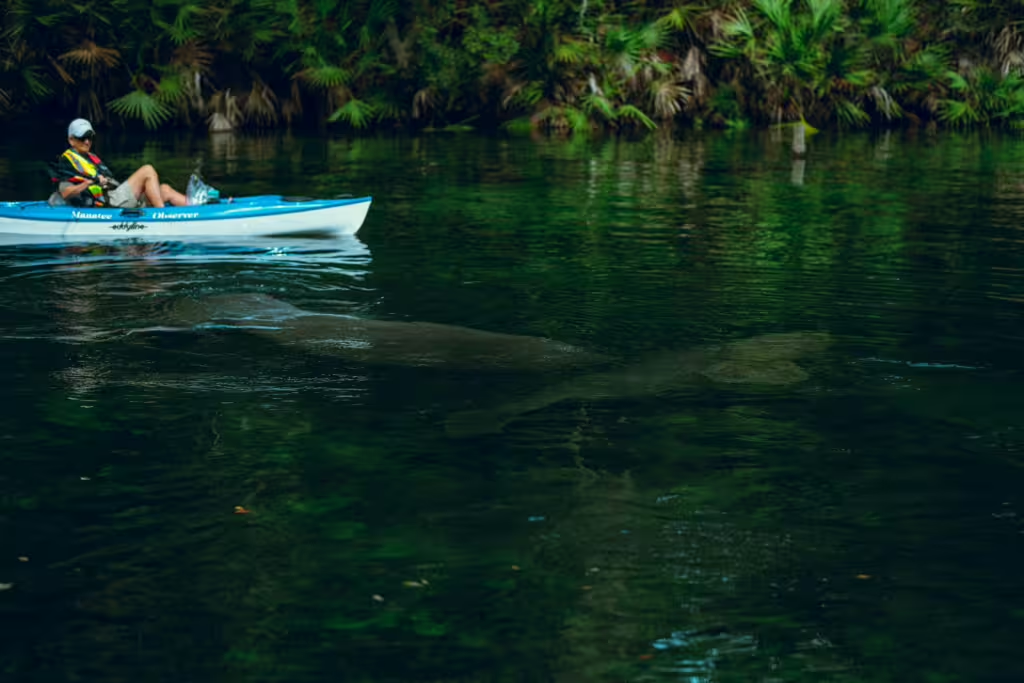
True Investigator Says…
As you can plainly see, manatees and dugongs are gentle, fascinating creatures that wouldn’t harm a fly…literally! These animals play a crucial role in the health of aquatic ecosystems and yet, despite their importance, they are being killed or forced out by human interference. Hopefully, as more people become aware of their plight, we will continue to find ways to ensure their continued survival. That way, these amazing sirenians won’t end up going the same was as their poor, extinct arctic cousins.
Discover more from TrueInvestigator
Subscribe to get the latest posts sent to your email.
